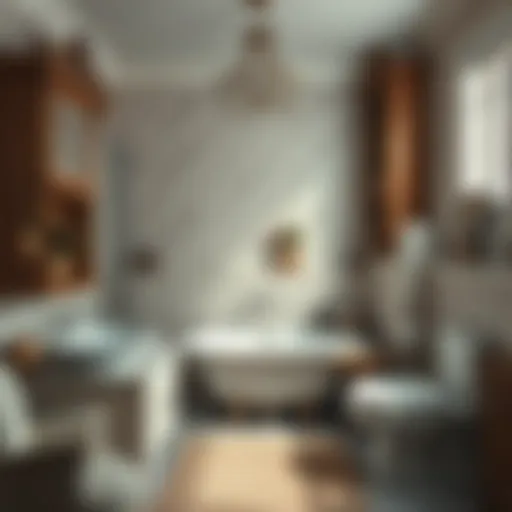Mosaic Backsplash Ideas for Elegant Bathrooms
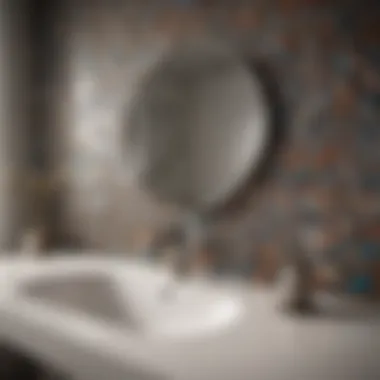

Intro
Mosaic backsplashes are an excellent way to enhance the aesthetic appeal of bathrooms. They offer a unique visual texture and can transform a mundane space into a stylish retreat. This article will explore the many options available for incorporating mosaics into bathroom designs, focusing on style, material, and color selection. Homeowners will find practical guidance for installation and maintenance, while design enthusiasts can take inspiration from current trends and timeless aesthetics.
Trending Styles
Modern Minimalism
Modern minimalism has taken the design world by storm. This style emphasizes simplicity and functionality, and mosaic backsplashes fit perfectly into this narrative. Designers often choose tiles with clean lines and muted colors. For instance, white or grey glass mosaics create a seamless backdrop, allowing other elements to shine, like fixtures or decorative items. The focus is on subtraction rather than addition, leading to serene and uncluttered spaces.
Cozy Rustic
On the other side, cozy rustic styles appeal to those looking for warmth and comfort. Mosaics made from natural stone or terracotta are ideal for this theme. They bring earthy tones and textures into the bathroom. A rustic mosaic backsplash can create a warm focal point that draws the eye. Pairing these tiles with wooden accents or vintage fixtures emphasizes the comforting atmosphere many homeowners desire.
Color Palettes
Calming Neutrals
Neutral color palettes are exceptionally versatile. Soft whites, beiges, and greys provide a calming environment, facilitating relaxation. For bathroom backsplashes, neutrals allow for flexibility in decor choices, harmonizing with various accessories and fittings. Opting for a mosaic in these tones helps maintain a cohesive look while bringing depth through texture.
Bold Accents
In contrast, bold accent colors can invigorate the bathroom space. Bright blues, deep greens, or vibrant reds can be utilized as eye-catching features in a mosaic backsplash. These tiles become focal points, energizing the overall design. Mix them with softer hues in other areas of the bathroom to create a balanced composition that feels both lively and thoughtful.
"Choosing the right mosaic is crucial not just for appearance but for how it fits the overall mood of the bathroom."
Culmination
Mosaic backsplashes in bathrooms are more than just functional elements; they are integral design features. By understanding trending styles and color palettes, homeowners can make informed choices that reflect personal taste and enhance the space. From modern minimalism to cozy rustic environments, there is a variety of options available. With the right approach to materials and maintenance, these backsplashes can be both beautiful and enduring.
Foreword to Mosaic Backsplashes
Mosaic backsplashes are not merely decorative but an important element in bathroom design. Their ability to enhance aesthetics, while serving as a functional barrier against moisture, makes them a popular choice. Homeowners often appreciate the diverse options in materials and styles, allowing for unique personal expression. It is crucial to understand the different aspects of mosaic backsplashes, including their definition, historical background, and various characteristics. These elements contribute to making informed design choices and ensure that the investment yields satisfaction in utility and appearance.
Definition and Characteristics
A mosaic backsplash consists of small pieces of material arranged to create a unified design. These materials vary widely, including ceramic, glass, and natural stone, among others. The primary characteristic of a mosaic is its versatility. Designers can use various colors, shapes, and textures, which allows for intricate patterns or simple arrangements, depending on personal preferences.
Mosaics can be customized to fit any space, ensuring each bathroom is unique. Besides aesthetics, they are also valued for their ease of maintenance. Grooming daily cleaning activities involves wiping down the tiles, which makes it practical for busy households.
Historical Context of Mosaics in Interior Design
Historically, mosaics date back to ancient civilizations. They were popularized by the Greeks and Romans, who utilized them in grand structures and wells. In the context of bathrooms, the utilization of mosaics evolved over the centuries. Consequently, the modern era has seen a resurgence of mosaic designs, particularly in homes.
The integration of mosaics in bathrooms represents a blend of form and function. Today, homeowners seek to combine historical influences with contemporary trends, ensuring that their spaces are not only beautiful but also timeless. This historical backdrop enhances the appreciation of mosaics as a significant element in modern bathroom design.
Materials for Mosaic Backsplashes
Mosaic backsplashes serve as both functional and aesthetic components in bathroom design. The choice of material significantly influences the overall appearance, durability, and maintenance requirements of the mosaic. Homeowners should consider not only the visual impact of each material but also how it performs in a humid environment like a bathroom.
Different materials cater to various design themes and personal preferences. For example, ceramic and porcelain are often chosen for their versatility and ease of maintenance. Glass mosaics add a sleek, modern feel, while natural stone brings timeless elegance. Moreover, metallic and unconventional materials can make bold statements in a bathroom setting. In the following sections, we will explore each category in detail, emphasizing their unique benefits and structural characteristics.
Ceramic and Porcelain Common Uses
Ceramic and porcelain are among the most popular materials for mosaic backsplashes. They are widely appreciated because they are easy to clean and maintain. Other advantages include wide availability in a variety of colors and designs. These materials can withstand moisture well, making them suitable for bathroom settings.
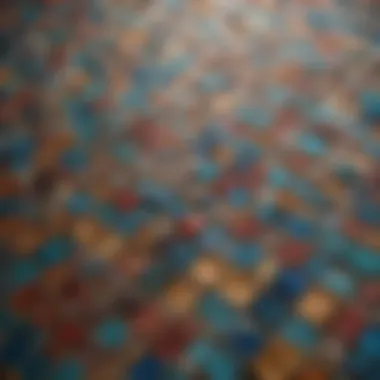

Ceramic tiles are typically made from natural clay and then glazed, which adds an extra layer of protection against water. Porcelain is denser and usually more durable than ceramic. It is often used for high-traffic areas due to its increased strength. Homeowners find these materials suitable for areas near sinks or around bathtubs, as they protect against splashes and stains.
Glass Mosaics: A Modern Approach
Glass mosaics are becoming increasingly popular in contemporary bathroom designs. The reflectiveness of glass adds a unique glow, creating a sense of depth in the space. This material comes in a multitude of colors and finishes, offering homeowners the opportunity to customize their designs extensively.
Installation often requires more precise techniques, as glass tiles can be more delicate compared to ceramic. However, their resistance to humidity and stains makes them an excellent choice for bathrooms. They are also resistant to mold and mildew, which are concerns in damp spaces. A well-designed glass mosaic backsplash can transform a simple bathroom into a luxurious and modern retreat.
Natural Stone: Elegance and Durability
Natural stone materials, such as marble, granite, and travertine, introduce a sophisticated charm to bathroom mosaics. These materials are celebrated for their durability. When well-maintained, they can endure the test of time.
However, natural stones do require sealing to prevent staining, especially in a bathroom where water exposure is consistent. Their unique textures and color variations create an organic appearance, adding character to the space. Homeowners often choose natural stone mosaics to achieve a high-end feel, particularly in master bathrooms or luxury guest bathrooms.
Metallic and Other Unique Materials
For those looking for something different, metallic mosaics and other unique material options can provide a striking contrast in bathroom designs. Materials like brushed aluminum or bronze can be used to add a modern aesthetic and elegance.
These materials often require less maintenance than natural stones and can be easier to clean. However, the reflective quality of metallic tiles can create unique light effects, enhancing the bathroom's ambiance. Homeowners may also consider hybrid mosaics, which combine various materials for a more eclectic look.
The choice of materials for mosaic backsplashes involves understanding the visual and practical implications of each type. The intended bathroom style, functionality, and personal taste are essential factors when making a selection.
Design Options for Mosaic Backsplashes
Design options for mosaic backsplashes are vital in shaping the overall aesthetic and functionality of bathroom spaces. The interplay of color, patterns, and materials allows homeowners to personalize their spaces while fulfilling practical needs. This section discusses the significance of selecting the right designs, the impact of various elements, and how they contribute to an engaging yet harmonious bathroom environment.
Color Schemes and Patterns
Choosing the right color schemes and patterns is essential in setting the mood of the bathroom. Warm tones such as reds and oranges can create a cozy feel, while cool tones like blues and greens promote tranquility.
- Monochromatic Palettes: This involves varying shades of a single color, creating a sophisticated look that is easy on the eyes.
- Contrasting Colors: Using colors from opposite sides of the color wheel can make bold statements. Think about how a white mosaic backsplash complements darker cabinetry.
- Patterns: From geometric to abstract designs, pattern choices can bring depth and interest. Mosaics arranged in creative patterns, like herringbone or chevron, add unique character.
When selecting colors and patterns, it is important to consider the size of the bathroom. Darker colors can make a small space feel tighter, while lighter shades can open up the area. Also, patterns should be scaled appropriately to ensure they do not overwhelm.
Geometric vs. Organic Shapes
Geometric shapes offer a contemporary feel with clean lines and structured order. Their predictable form can lend a sense of precision, which aligns with modern design philosophy. On the other hand, organic shapes bring a softer, more fluid aesthetic, mimicking natural forms and irregularities found in nature.
- Geometric Mosaics: Squares, rectangles, and triangles can be arranged in ways that create visual intrigue while maintaining a sense of harmony. These shapes work well in minimalist designs.
- Organic Mosaics: Wavy lines and freeform shapes create a relaxed atmosphere. They work particularly well in bathrooms where a spa-like environment is desired.
Mixing these two approaches can produce compelling results. A primarily geometric backdrop can be accented with organic mosaics, which keeps the design fresh and engaging without sacrificing cohesiveness.
Combination with Other Materials
Combining mosaics with other materials is another way to achieve a unique backsplash design. This method enables better texture and contrast, enhancing the visual appeal of the space.
- Glass and Tile: Combining glass mosaics with ceramic tiles can create layers of shine and matte finishes. This complexity adds interest and depth to the design.
- Stone and Metal: Integrating natural stone mosaics with metallic elements—such as brass or stainless steel—can create a luxurious feel. The warmth of stone combined with the coolness of metal can be visually striking.
- Wood Accents: Incorporating wooden elements with mosaics can soften the overall look. Wood brings warmth and pairs well with colorful mosaic designs, balancing modern and rustic styles.
It is vital to ensure that these combinations maintain the overall harmony of the space. The key is to select materials that complement each other rather than compete for attention.
"A well-thought-out mosaic design can transform an ordinary bathroom into a stunning visual masterpiece, merging functionality with style."
By carefully considering color schemes, shapes, and material combinations, homeowners can create a bespoke mosaic backsplash that enhances their bathroom’s functionality and aesthetic. The right choices can lead to a truly personalized environment that resonates with the user’s tastes and preferences.
Functionality and Practicality of Mosaic Backsplashes
Understanding the functionality and practicality of mosaic backsplashes is essential for homeowners and design enthusiasts. This section addresses how these backsplashes meet both aesthetic and practical requirements. Besides contributing to the overall design of a bathroom, they offer features like water resistance, easy maintenance, and long-lasting durability.
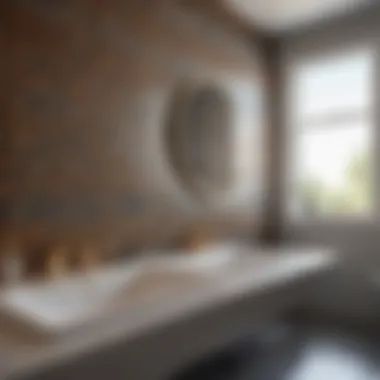

Water Resistance and Maintenance Concerns
Mosaic backsplashes are typically installed in areas exposed to moisture, making water resistance a key factor. Most materials used in mosaics, such as glass and porcelain, are inherently resistant to water. This quality prevents mold and mildew buildup, which can be a significant concern in bathroom environments. To maintain their functionality, regular cleaning is essential. A simple solution of warm soapy water or specialized tile cleaner often suffices.
When it comes to grout, sealants are recommended to enhance water resistance further. Over time, grouts can absorb moisture, leading to discoloration and structural issues. Sealing the grout every year or so will help maintain its appearance and integrity. Homeowners should also be mindful of stains from products like soap or shampoo. Quick cleaning of spills will keep the mosaics looking fresh.
Durability and Longevity Considerations
Mosaic backsplashes are noted for their durability, an important consideration for any bathroom installation. Materials such as natural stone, glass, and high-quality porcelain are built to withstand wear and tear. These materials resist chipping and scratching, which is especially important in high-traffic areas.
Unlike other types of backsplashes, mosaics do not easily fade in color, even when exposed to harsh bathroom conditions, like steam and moisture. Depending on the material, many mosaics can last for decades without needing replacement.
Maintaining the longevity of a mosaic backsplash also depends on the installation process. Properly adhered tiles will remain intact for much longer. Choosing an experienced installer can significantly impact the outcome and lifespan of the mosaic design.
Installation Process
The installation process plays a crucial role in ensuring that mosaic backsplashes are both aesthetically pleasing and durable. A well-executed installation guarantees that the mosaic tiles adhere correctly, resulting in a long-lasting, beautiful surface. Proper preparation can mitigate potential issues such as misalignment or peeling over time. The steps involved in installing a mosaic backsplash can be divided into three main phases: preparing the surface, selecting and applying adhesive, and grouting techniques along with finishing touches. Each step requires attention to detail and a clear understanding of the materials involved.
Preparation of the Surface
Before laying the mosaic tiles, it is essential to thoroughly prepare the surface. A clean and smooth base ensures better adhesion of the tiles. Start by removing any old materials or grime from the walls. Use a combination of scrapers and cleaners to eliminate loose paint or plaster, as these can inhibit adhesion. It is also vital to check for moisture issues that might affect the installation later, particularly in bathrooms where humidity levels may fluctuate.
After cleaning, inspect the wall for uneven areas. If necessary, use a leveling compound to address any irregularities on the surface. When applying this, make sure to let it fully cure before proceeding with the installation. Finally, ensure the surface is dry; any residual moisture can jeopardize the adhesion of the tiles.
Adhesive Selection and Application
The right adhesive is key for successful mosaic installation. For bathroom environments, a thin-set mortar is often preferred. This type of adhesive provides strong bonding and supports the weight of the tiles. When selecting a glue, consider factors like moisture resistance, flexibility, and compatibility with your chosen tile material.
To apply the adhesive properly, first, spread it evenly on the wall using a trowel. The size of the trowel notches will depend on your tile's size; larger tiles may require wider notches. Press the mosaic tiles firmly into the adhesive, twisting them slightly to ensure complete contact. Maintain consistent spacing between the tiles, as this will be essential for grouting later on. After placing the tiles, allow the adhesive to cure per the manufacturer's instructions.
Grouting Techniques and Finishing Touches
Once the adhesive has set, the next phase is grouting. Grout fills the spaces between the tiles and adds structural support. Select a grout that is suitable for wet areas, generally a sanded grout for larger gaps and unsanded for thinner spaces. Mixing grout requires care; follow the instructions closely to achieve the right consistency.
To apply the grout, use a rubber float and spread it diagonally over the tiles. This method ensures it fills the gaps efficiently. It’s important to work in small sections. After the grout has begun to set, take a damp sponge to wipe off excess from the tile surfaces without removing it from the gaps.
Finally, once the grout has cured, consider sealing it. A grout sealer will protect against stains and moisture, extending the lifespan of your mosaic backsplash.
"A well-installed mosaic not only enhances the visual appeal but also provides lasting functionality in a bathroom."
Trends in Mosaic Backsplash Designs
Understanding the trends in mosaic backsplash designs is crucial for anyone interested in bathroom renovations. Mosaic backsplashes offer not only visual appeal but also customizable options for different tastes and styles. As design preferences shift, homeowners seek to incorporate elements that reflect current aesthetics while still maintaining functionality. Recognizing these trends can guide choices to enhance both the look and feel of the bathroom.
Current Popular Styles
Currently, several styles of mosaic backsplashes are gaining traction in bathroom design. Here are a few:
- Subway Tiles with Mosaic Accents: The classic subway tile remains steadfast. However, integrating mosaic accents brings a fresh twist, often adding color or texture without overwhelming the space.
- Bold Geometric Patterns: Many designers favor geometric shapes for their modern appeal. These patterns can create dynamic visuals, making a statement in any bathroom.
- Earthy Natural Stone Colors: Earth tones are popular for their calming effect. Mosaics made from natural stones such as travertine or slate offer not only elegance but also durability suitable for bathroom settings.
- Metallic Finishes: Incorporating metallic mosaics adds a touch of sophistication. They can be used in small areas to create highlights, offering a luxurious look without excessive decoration.
These styles cater to diverse tastes, making it easier to blend with various interior designs.
Innovative Uses in Contemporary Spaces
Mosaic backsplashes are not limited to traditional applications. Innovative uses are emerging that push boundaries in bathroom design. For instance:
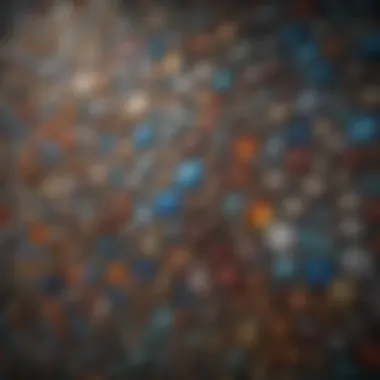

- Shower Walls: Mosaics are increasingly being applied on shower walls as artistic backdrops. This creates a focal point that can enhance the overall aesthetic of the bathroom.
- Accent Walls: Instead of covering the entire wall with mosaics, designers are using them to create accent walls, contributing an eye-catching element without overwhelming the space.
- Combined Materials: The combination of mosaics with other materials, such as wood or glass, introduces intriguing contrasts and enriches textural diversity. This trend is especially appealing in contemporary designs, where mixing styles can produce unique results.
- Lighting Effects: Some contemporary designs incorporate lighting behind or around mosaic tiling. This can highlight the intricate patterns and colors, transforming a simple backsplash into a radiant display.
Incorporating mosaics in innovative ways can elevate bathroom design, creating unique environments that reflect individual styles.
Overall, staying informed on these trends allows homeowners to make educated choices in their bathroom projects. A mosaic backsplash not only serves as a practical solution but also as a medium to express personal creativity.
Comparative Analysis: Mosaic vs. Other Backsplash Types
In the realm of bathroom design, selecting the correct backsplash is a vital decision that affects both aesthetics and functionality. This section conducts a comparative analysis of mosaic backsplashes in relation to other prevalent backsplash materials. Understanding these differences allows homeowners to make informed choices about which option will best meet their design goals and practical needs.
Traditional Tile Backsplashes
Traditional tile backsplashes offer a classic aesthetic with a wide range of materials, colors, and finishes. Generally made of ceramic or porcelain, these tiles are known for their durability and ease of maintenance. Here are a few points to consider:
- Versatility: Traditional tile can complement numerous styles, from rustic to contemporary.
- Cost-effective: They usually come at a lower price than mosaic options, making them appealing for budget-conscious homeowners.
- Installation Ease: Their standard size and shape facilitate simpler installation compared to the intricate layout often required for mosaics.
However, these tiles lack the intricate beauty and customizable designs characteristic of mosaics. They often present a less unique look as designs can become more uniform in style.
Vinyl and Peel-and-Stick Options
Vinyl and peel-and-stick backsplash options have gained popularity due to their simple installation process and affordability. Made from PVC or similar materials, these options cater to those looking for a quick upgrade. Key features include:
- Ease of Use: These options are designed for DIY projects, allowing homeowners to install them without professional help.
- Cost Efficiency: Typically, they are more affordable than mosaic tiles, making them a tempting choice for budget renovations.
- Versatility in Design: Available in numerous patterns and colors, they can simulate the look of more expensive materials.
Despite these advantages, vinyl and peel-and-stick options usually lack the durability and authenticity of genuine materials, such as mosaic tiles. Over time, they may peel off or fade, particularly in high-moisture environments like bathrooms.
In summary, this analysis underscores the key differences between mosaic backsplashes and more traditional varieties. Considering elements such as cost, aesthetics, and installation can greatly influence the decision-making process when it comes to enhancing bathroom spaces.
Case Studies of Successful Mosaic Installations
Case studies play a pivotal role in understanding the practical impact of mosaic backsplashes in bathroom design. By examining how these installations function in real-life scenarios, homeowners can garner insights on style, material choices, and maintenance considerations. Successful applications highlight not only aesthetic appeal but also the practical benefits that mosaics afford. Each case study serves as a tangible example, illustrating the versatility of mosaics and their alignment with various design philosophies. Furthermore, analyzing these installations can help in addressing any apprehensions related to their upkeep and longevity in the constantly evolving design landscape.
Residential Applications
In residential settings, mosaic backsplashes frequently become focal points that enhance the overall ambiance of the bathroom. Homeowners have used materials like glass and ceramic to create stunning visual statements. For instance, one case study involved a homeowner who opted for a blue glass mosaic backsplash. This installation not only complemented the white cabinetry and neutral tiles but also introduced a refreshing burst of color. The interplay of light across the glass tiles ultimately achieved a tranquil and luxurious atmosphere, ideal for a calming bath experience.
Another noteworthy example is the use of natural stone mosaics in a vintage-style bathroom. Here, small pebble mosaics were incorporated around a freestanding tub, driving a visual connection with nature. This design choice integrated seamlessly with the fixtures and surrounding decor, promoting a spa-like feel. Homeowners reported satisfaction not just with the aesthetics but also with the easy maintenance involved in cleaning these surfaces.
Commercial Spaces and Their Unique Designs
Commercial spaces have increasingly embraced mosaic backsplashes as a means of branding and creating striking visuals. A well-known boutique hotel utilized a bold geometric pattern in varying shades of teal and white in their restrooms. This design not only created an Instagram-worthy backdrop for guests but also reinforced the hotel's stylish and modern identity. The durability of the materials chosen ensured that the mosaics could withstand the heavy foot traffic typical of a commercial setting.
In another case, a high-end restaurant opted for a metallic mosaic backsplash in the women’s restroom. The reflective quality of the tiles contributed to a luxury experience. Patrons commented positively about the environment, noting that the ambiance was as important as the culinary offerings. Such installations serve a dual purpose: they not only attract customers but also help in establishing a brand image.
The mosaic backsplashes in both residential and commercial applications demonstrate how this design feature can balance functionality with artistic expression. Prospective users can draw crucial lessons from these case studies, providing them the confidence to proceed with their mosaic backsplash projects.
Epilogue: The Future of Mosaic Backsplashes in Bathroom Design
The importance of mosaic backsplashes in bathroom design cannot be overstated. These elements are not merely decorative; they also serve functional purposes. As such, understanding the future trends and implications of mosaic backsplashes is vital for homeowners and designers alike. With a variety of materials and designs available, mosaic backsplashes present ample opportunities to enhance aesthetic appeal and elevate the overall ambiance of the bathroom.
Sustainability Considerations
Sustainability is becoming a crucial factor in modern design choices, including mosaic backsplashes. Many households are moving towards eco-friendly options that utilize recycled materials. For instance, glass mosaic tiles made from post-consumer waste reduce environmental impact while providing an attractive finish. Homeowners may also look for tiles that are sustainably sourced, considering the lifecycle of the materials used.
Moreover, reducing water consumption during installation and maintenance is an important aspect of sustainable practices. Selecting materials that are both durable and low maintenance will extend their life span, minimizing waste over time. By adopting such practices, homeowners not only contribute to environmental conservation but can also enjoy cost savings on water and upkeep.
"Emphasizing sustainability in building materials is not merely an aesthetic choice; it is a commitment to a more responsible future."
Personalization and Uniqueness in Design
Mosaic backsplashes offer unparalleled options for personalization. Homeowners are increasingly looking for design elements that reflect their individual style. The unique patterns and color combinations that mosaics allow can transform a mundane area into a statement piece. This is particularly significant in bathrooms, which traditionally have less decorative potential compared to other spaces in the home.
There is also the option to create custom mosaics featuring personal imagery or motifs, an aspect that adds meaning to the design. Using a mix of materials and shapes can create a more dynamic visual effect, resonating with the personality of the user. Designers and homeowners who embrace these unique possibilities can craft bathrooms that are not just functional but also expressive.











